Perspectives on Past, Present and Future of Clinical Trials
As we mark a milestone year for our publication, several guest contributors look at the complexity issues in drug development still to overcome.

This month, as we celebrate the 25th Anniversary of Applied Clinical Trials, our survey partner, SCORR Marketing, helped develop the “The Past, Present and Future of Clinical Trials.” We think the survey does justice to the current trends in clinical trials that definitely speak to the changes occurring now, as well as the near future.
Following the survey results, in the pages ahead, we include contributions from our Editorial Advisory Board members on the topic “How Can We Gain Efficiencies in Clinical Trials?”; from Schulman IRB on what the institutional review board of the future will look like; from Tufts CSDD, which lays out futurists’ views of the clinical research enterprise; Veeva Systems offers its take on clinical technology; Duke Clinical Research Institute a view for collaborative and patient-centered clinical trials; and, finally, a reflection on Good Clinical Practice from a former EAB member.
Professional roles changing
One aspect of trials that has changed significantly in the past five years, and one that we have addressed in our pages, is the job functions of certain key roles, including clinical research associates (CRAs), data managers, project managers and regulatory affairs.
However, of all of those roles, our survey found that most respondents believe the CRA role has had the
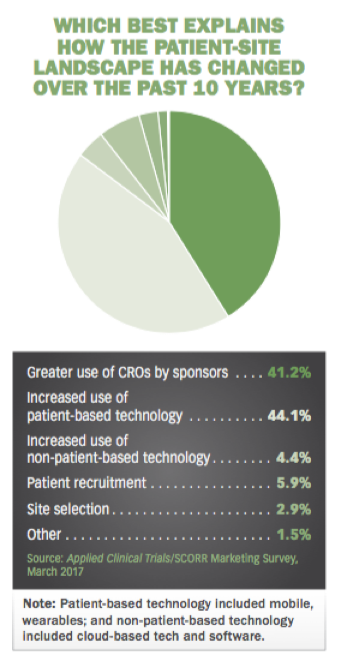
most change in the past 10 years. The survey indicated that the increasing use of technology, as well as the implementation of risk-based monitoring (RBM) strategies, are the two main game-changers for CRAs. We do know that when RBM was first addressed by FDA guidance, and CROs and sponsors began to actively look to RBM as a monitoring alternative, it was a difficult change management process for everyone involved. CRAs have been instructed away from checking data on forms and 100% source document/data verification to more of a proactive advisory position at the sites.
And when asked about the prospects for the next five years, the majority of respondents believe that the CRA will still face the most change. This was followed by project managers, data managers and regulatory professionals.
Changes in the trial landscape
The survey also explored reasons for more complexity in clinical trials, as well as the state of patient recruitment and site selection. For the reasons behind the complexity of clinical trials, respondents rated endpoints, eligibility criteria and adaptive trials, in that order.
The increase in the use of social media was, overall, the top change in patient recruitment in the past 10 years. And for site selection, the increased competition for sites was overwhelmingly chosen-at 56%-as the biggest change in the past decade.
Finally, we explored changes in the relationship between sites and patients. In the next five years, respondents believe that use of biomarker data for patient identification will impact that dynamic, followed closely by the use of electronic health records, again for patient identification into a clinical trial. The direct-to-patient trial did garner a 22% response to that question, and clinical trials as a care option 19%.
For your free copy of the survey report, please download here.
- Lisa Henderson, Editor-in-Chief
Making Clinical Trials More Efficient: EAB Perspectives
Select members of Applied Clinical Trials’ Editorial Advisory Board share their thoughts on ways industry can realize the promise of more efficient drug development in the years ahead
Wayne Kubick, Chief Technology Officer, HL7International
The best way to make trials more efficient is to ride the wave of expanding better quality digital health data to improve the research process. The HL7 FHIR (Fast Healthcare Interoperability Resources) standard, called “the HTML of Healthcare” by John Halamka, has opened a new window into electronic health

records that can be easily accessed by patient-focused apps and their authorized caregivers through APIs. As more and more patients use their data to manage their own health, together with new payment models focused on wellness and outcomes that rely on clinical data, the breadth, depth and accuracy of healthcare will continue to improve.
The FHIR standard provides a modern technology platform and model for consistent representation of health data as resources, and an active community working collaboratively toward achieving semantic interoperability. And the increased insights FHIR brings can inform better trial designs, more streamlined processes for randomized, pragmatic and observational trials, and better awareness of protocol execution at the site and the effects of new drug and device introduction on patients.
For an industry that needs to reach out more to its customers, FHIR can open new channels of communication with providers and patients and opens up a whole new world of possibilities for the biopharmaceutical industry.
Stewart Geary, Deputy Director, Eisai Co. Ltd.
My work is in drug safety both during clinical trials and postmarketing, and I get to see how regulatory authorities, ethics committees and investigators use and respond to our safety information during clinical development.
I think there are two broad areas where we could be more efficient in the management of safety information in clinical trials.

Regulatory overreach and inconsistency continue to be a periodic problem, especially in Europe where over the past year and a half, sponsors have had to respond to a variety of instructions from individual assessors on how reference safety information is described in the investigator’s brochure. In many cases, the instructions are inconsistent between assessors (different assessors have conflicting requests), are sometimes inconsistent even with the stances the CHMP (The Committee for Medicinal Products for Human Use) or PRAC (Pharmacovigilance Risk Assessment Committee) have taken on approved labeling for the compound and are not consistent with what has been considered good pharmacovigilance practice internationally. This has caused delays in the approval of these key regulatory documents, which can mean a delay in starting trials in Europe; this adds to clinical development cost and complexity. Unfortunately, there is no evidence that the new requests contribute to clinical trial subject safety. Regulation is a significant driver of the excessive costs of clinical trials-and as a community of investigators, regulators and sponsors we should promote regulatory simplification and rationalization.
We currently do very little to tailor the collection of safety information to the scale or indication of the clinical trial. A 10,000-plus patient outcomes trial that is focused on an outcome of death or serious disability will collect the wide variety of lab tests, non-serious adverse events, physical signs and symptoms that are collected in smaller trials at the beginning of a clinical development program.
Source data verification for that data collection is incredibly expensive in very large trials. We should do more to tailor our requirements for data to the scale and purpose of the study so that large outcome trials-which can provide vitally important information on the true benefits of therapies-become more feasible.
Kiran Avancha, Chief Operating Officer, HonorHealth Research Institute
Academia has a specific process in which they conduct efficient clinical trials. At HonorHealth Research Institute, we have a strong early Phase I, early drug development program in oncology. We constantly tend to make these clinical trials more efficient with less sample sizes through the innovative design of a particular trial itself.
Most of the clinical trials that we do are first-in-humans, so preclinical testing is finished on animals and

“cell lines,” which results in very robust data. We have world renowned physicians who look at these studies and design early drug development clinical trials.
There are outstanding gains and significant progress that we have made in cancer research over the last ten to twenty years that have resulted in improved survival rates and benefits. Both from early diagnosis to new drug molecules being developed and new mechanisms of actions for these molecules being developed. Advances in biomarkers are also helping us to approach clinical trials differently. It’s more targeted, it’s more biomarker-driven and it’s not “one size fits all.” We have made significant progress in the last five to seven years in understanding how biomarker-driven processes work.
There is a tighter net in the scientific community that has opened doors for the process of sharing data, which is causing an increase in momentum and speeding up some of these discoveries.
The traditional paradigm is that we use a standard approach, build a protocol and rigorously carry out the study. However, then it may take five years to complete the study because nobody knows about or has enrolled in these clinical trials. If you look at National Cancer Institute data, more than half of clinical trials close because of poor recruitment.
We have made significant progress in pediatric oncology, because every patient is being treated on a clinical trial for those kinds of research.
If the traditional paradigm is to change, we need to think about large clinical trials. I’ve seen smaller trials, new statistical designs and smarter ways of doing trials come into the industry.
And the industry is getting smarter in doing many of these things. Academic institutions and scientists domestically and globally are connecting to get this problem solved. I think we also need to ensure that regulatory burdens are reduced for us to excel faster.
Ashok Ghone, VP, Global Services, MakroCare USA
Aggressive financial targets and R&D budgetary constraints are building tremendous pressures on life sciences companies to develop new drugs/devices in a cost-efficient and timely manner. With the increased complexities of clinical trials in the last few years, even the cost of clinical trial management has been increasing steadily. In order to manage these challenges, one of the areas that life science companies can

focus on is improving the efficiency of the clinical trial management process to get better control and visibility and improve speed.
Use of new approaches in the clinical trial management process, like new monitoring initiatives-risk-based monitoring, centralized monitoring, etc.-not only help to build better data quality, improve study conduct and close monitoring of patient safety, but also help to optimize clinical trial cycle time, provide better clarity on operations on a real-time basis and create cost efficiencies in the long run. The life sciences industry needs to seriously look into implementing these approaches to get more visibility across the trial management process and facilitate proactive measures to protect their investment. Even the regulators are encouraging industry to use these new initiatives to improve overall clinical trial performance and quality.
With penetration of new technology and eClinical tools, such as advanced analytics, eTMF, eSource, etc., one can have better and real-time visibility on what’s happening in clinical trials and take proactive, corrective actions whenever required to prevent issues.
Integrating standard processes with right technology and using highly trained people to drive the processes will be the key to success. Proper use of emerging new roles like risk managers, central monitors and data scientists and initiatives such as encouraging cross-functional coordination, identifying and utilization the across-functional expertise to bridge the gaps in the processes would be helpful.
The Path to Unified Clinical
While innovation in the life sciences industry has accelerated over the past several decades1, the time required to bring new medicines to market has remained long and the effort to develop them has become increasingly complex.2
The current model will not accommodate the growing number of trials and rise in complexity. A next-generation model is needed to drive new levels of efficiency and effectiveness across the entire clinical ecosystem.
New era of unified clinical is underway
A significant transition has started to create a unified clinical environment across end-to-end trial processes. Looking ahead, a unified clinical environment will include five major characteristics:
A common language for clinical trial information
The first step toward a unified clinical environment is harmonizing trial information. Today, different data models and vocabularies exist that refer to the same trial documents, content, and information. This makes it difficult to complete work accurately and efficiently or gain insights when the same information is named or categorized differently.
Now, the industry is creating a common language for how clinical teams talk about information and refer to the same content and data within their own processes. The Clinical Data Interchange Standards Consortium (CDISC), TransCelerate BioPharma, and the Drug Information Association (DIA) are three groups working to create a common language so that the puzzle pieces of information and data across trials can be put together efficiently and effectively.
A universal and flexible operating model
There is tremendous opportunity for the industry to create a common framework that standardizes trial processes, while still enabling flexibility to support individual study needs. An agile operating model can eliminate the rework that takes place with each new trial and reduce the time to full study optimization.
Rigid information systems often exacerbate the challenges in adopting a common model because they limit the flexibility of a business process and force people to find workarounds to complete tasks at hand. To achieve a universal and flexible operating model, sponsors, partners, investigators, and others will adopt universal industry processes to find the most efficient way to conduct trials, but still be able to manage variability from study to study.
The collaborative clinical ecosystem
Moving to a unified clinical environment will also require shifting from specialized and siloed processes to ones that fit into a common framework across all trial activities. Part of that process should include establishing shared goals, objectives, and outcomes to foster collaboration and incentivize teams to transfer knowledge and follow end-to-end trial processes. Also, integrating stakeholders early in decision-making on areas such as protocol design builds trust among stakeholders that they are working toward the same outcomes.
Insights from metrics and measurements
Common operational metrics and measurement will also be fundamental to a unified clinical environment, providing insights to manage risk, take action, and implement process improvements, as well as allow for industry benchmarking, reporting, and feedback.
Performance metrics give a view into the ongoing status and quality of a trial and can help identify overall trends to drive process improvements across a portfolio of studies. This information then becomes a strategic asset to perform predictive analysis across multiple sites and studies using real-world evidence and historical operational metrics to better inform future trials.
Modern and unified information systems
Most clinical teams work in many different systems and often without the benefit of direct collaboration between teams, either internally or externally. Content and data is collected and managed from sources, even though the information is all associated with the same study.
Now, life sciences companies are bringing together previously disparate systems with emerging, native cloud solutions to support the end-to-end trial process and collaboration among partners. Connected cloud applications manage both content and data to eliminate information and process silos. Clinical information systems that are inherently integrated by leveraging a single platform will be essential in propelling the industry toward a unified clinical environment.
Into the future with a unified clinical model
There is a tremendous opportunity for life sciences companies to transform their operations and processes through a unified clinical environment. Moving to this next-generation clinical model will better enable the industry to address the growing complexity of trials, support end-to-end trial processes, and drive new levels of efficiency and effectiveness across the entire clinical ecosystem.
- Jennifer Goldsmith, Senior Vice President, Veeva Vault, Veeva Systems
References
1. Forbes, 2015, “New Drug Approvals Hit 66-Year High!” (January 4, 2016)
2. Tufts Center for the Study of Drug Development, Outlook 2016 (January 2016)
How the Cures Act Will Impact Clinical Development
A look at provisions of the legislation with the best chance of preserving trial safeguards
Despite vast bipartisan support, when the 21st Century Cures Act was passed in early December, it was met with immediate criticism. The Cures Act provides more than $6 billion in research dollars, including funds for opioid addiction research, precision medicine and the Cancer Moonshot program, and represents the largest piece of healthcare legislation since the Affordable Care Act. Several provisions, however, amend the review and approval processes of the FDA and other regulatory bodies-controversial changes that will shake up drug and medical device markets in unprecedented ways.
Not surprisingly, these changes have been met with a considerable degree of angst. When there is talk of streamlined regulatory reviews and expedited approvals, it is natural to question which steps will be cut out of the process, and if we can afford to lose them. Frequently, we see validation in passing multiple checkpoints, especially ones that have been in place for a long time.
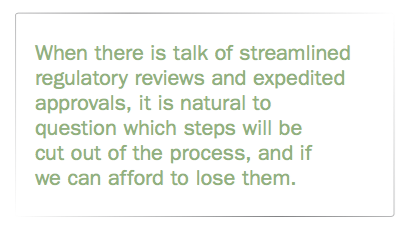
But we must ask ourselves: In the face of a growing gap between supply and demand for life-saving treatments, is it ethical if we never stop to question whether we can confidently stand by the measures by which we define risk and benefit?
Among others, the following provisions of the Cures Act could successfully preserve conscionable safeguards of safety and efficacy, eliminate undue development hurdles, and increase patient access to breakthrough treatments.
Central IRBs for medical device studies [section 3056]
Today, sponsors of a multisite device research protocol are faced with an exponentially higher administrative burden than those conducting single-site non-device investigations, because of a local review requirements specific to research with devices. Thus, a 15-site study involving an investigational device could involve 15 local institutional review boards (IRBs), each with its own requirements. This means that each IRB can (and often does) request changes to protocols as well as consent forms, resulting in significant delays and complications as revisions are made to satisfy the disparate requests.
Section 3056 of the Cures Act comes on the heels of an NIH policy, effective this September, which establishes the expectation that a single IRB of record will be used for NIH-funded multisite studies. The Cures Act provision strikes the statutory requirements that medical device clinical investigations be overseen by a “local IRB,” permitting both investigational drug and device research to have a single IRB of record in multisite studies.
Moving forward, with research protocols being reviewed once on behalf of all sites and the sponsor responding to only one IRB’s feedback, study timelines can be planned more accurately, and sponsors and sites can focus more on overall study management and safety. In addition, the IRB can work with the sponsor to develop a unified informed consent for use by all sites, so subjects receive consistent information
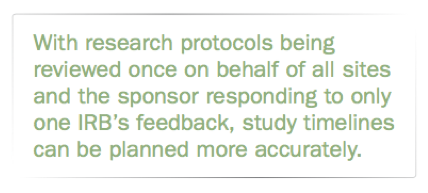
over the course of the study regardless of where they may be enrolled.
Along with the recent final revisions to the Common Rule, the Cures Act provision has driven home the federal government’s message that where multisite research is concerned, a single IRB is now the preferred course.
Through centralized oversight of multicenter medical device studies by a single IRB, we can minimize administrative burdens, costs and delays while accelerating a scientifically sound review and approval process.
Harmonization of informed consent [sections 3023–4]
Harmonizing government regulations has been a significant ask by the national community, evidenced by the existence of the HHS Secretary’s Advisory Committee on Human Research Protections Subcommittee on Harmonization, which is tasked specifically with providing guidance on regulatory issues that would benefit from harmonization.
Section 3023 of the Cures Act addresses this demand by requiring harmonization of the differences between the HHS Common Rule and FDA regulations. Specifically, the provision calls for the Secretary of HHS to synchronize the two sets of regulations “to the extent practicable and consistent with other statutory provisions” within three years of the Cures Act’s enactment. The goal? To minimize regulatory duplication and undue delays, to facilitate multisite research and to incorporate local considerations and protections of vulnerable populations.
The disparity of informed consent regulations between HHS and FDA has been a longtime complication for clinical researchers. It is not an uncommon scenario for a human subject’s informed consent to be waived under HHS but not under FDA regulations. This is particularly difficult with respect to research involving the collection of specimens.
Furthering this provision’s harmonization efforts, section 3024 goes on to amend the Federal Food, Drug and Cosmetic Act to grant FDA the ability to allow waiver or alteration of informed consent for investigational drug and device studies when research activities post no more than minimal risk and include appropriate protections for the subjects’ rights, safety and welfare. Finally, FDA and HHS will be consistent in this regard.
Prioritization of breakthrough and humanitarian use devices [sections 3051–2]
Patient demand for access to investigational new drugs has grown in recent years, as seen through increased social media activity and the “right-to-try” laws on the books in many states. The Cures Act may help to close the gap between supply and demand for breakthrough and humanitarian use devices that would benefit patients suffering with difficult-to-treat conditions.
Section 3051 of the Cures Act builds upon the Expedited Access Pathway (EAP), a voluntary program designed to prioritize the review of certain devices for life-threatening or irreversibly debilitating diseases. Finalized in guidance published in April 2015, the EAP is a program in which the FDA works with sponsors to minimize medical device development costs and timelines while maintaining the same standards for safety and effectiveness. Per the Cures Act legislation, this Pathway would now be open to additional device types, increasing the number of breakthrough devices receiving priority review.
In addition, as a counterpart to the orphan drug designation, for which the FDA has seen a dramatic rise in requests in recent years, the humanitarian device exemption (HDE) is expanded in section 3052 of the Cures Act. Currently, the exemption can only be applied to devices that treat diseases and conditions that affect up to 4,000 individuals annually in the U.S. The new legislation raises this cap to 8,000. This will allow sponsors to obtain approval based on safety data and probable benefit and increase patient access to devices for a greater variety of rare conditions.
- Michele Russell-Einhorn, JD, Vice President of Human Research Protection Services and Institutional Official, Schulman IRB
The Future of Clinical Research: An Academic Organization’s View
Patient-centered collaboration will be key
Whenever experts are called upon to predict the future of clinical research, we hear a familiar litany: Pharmaceutical companies must evolve and accelerate their R&D efforts. Contract research organizations (CROs) need to innovate in recruiting study participants and find ways to make site-based research and monitoring more efficient. And if the “usual suspects”-industry, CROs, academia, regulators, and physicians-can just figure out how to handle all this rapidly accumulating big data and put it to good use, patients and the public will benefit.
It’s reasonable to ask, though, why we aren’t there yet. After all, kitchen appliances are now hooked up to the Internet, self-driving cars are easing onto the freeways, and artificial intelligence is helping people do their shopping without leaving the couch. Perhaps more relevantly, we’re living in an era in which individual whole-genome assays are within reach and sophisticated medical devices can be custom-printed as needed. When we look three, five or 10 years ahead, we see multiple influences-technological, organizational, and cultural-that seem poised to propel clinical research rapidly into the future. Yet, as important as these factors are, it’s becoming clear that the key to unlocking the full potential of clinical research is held not by the “usual suspects” noted above, but by patients themselves.
At the Duke Clinical Research Institute (DCRI), our clinician-researchers encompass a great many different specialties and interests, but they all share a commitment to turning research into better patient outcomes. From our unique vantage point as the world’s largest academic research organization, we’ve become
Source: Duke Clinical Research Institute, via Hernandez, AF, and Cruz, HP. Circulation. 2017; 135:1478-1480. Click to enlarge.
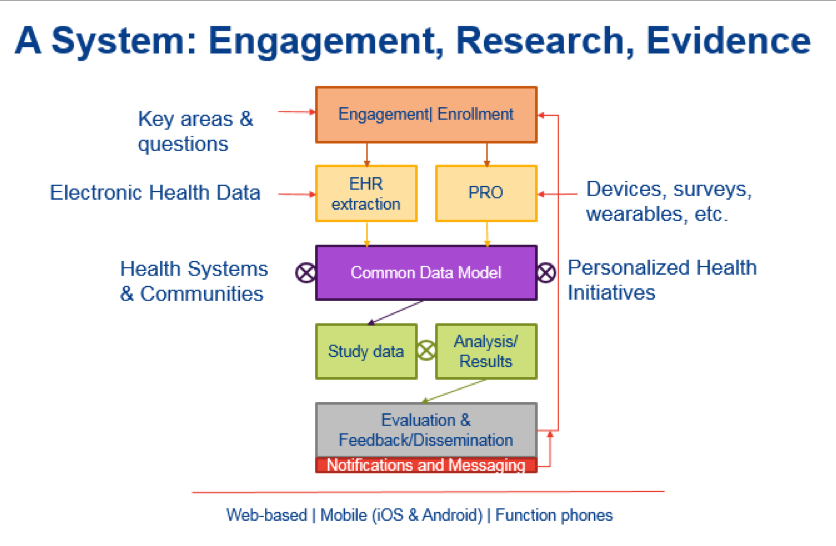
increasingly convinced that those who will serve as the core catalyst for advancing clinical research are the ones who have the most at stake in improvements and innovation in healthcare-patients and the public. We believe the future of clinical research centers on engaging people, including people who are currently healthy, in partnering with caregivers and scientists to understand their health-related experiences to answer stubborn questions and create solutions that improve care and outcomes.
Today, roughly 15% of people in the population are “patients” in some sense at any given time. But the remaining 85%, while not currently patients as such, are, nevertheless, capable of adding tremendously to medical knowledge. So many unanswered questions about predictors of health and illness, the importance of environmental exposures, the roles played by societal and behavioral factors, even the effects of the consumer products we use and the food we eat, can be answered if we can find ways to tap into the insights that technology and our networked lives are now making possible. Electronic health records are just the start. Granular information from digital devices and sensors, shopping preferences from retail and grocery store purchases, and lifestyle choices from social media profiles can be woven into a vivid tapestry of real-world evidence that illuminates patterns of health and illness that would otherwise remain hidden.
It is both our goal-and our role-to invite all stakeholders to partner with us in building an efficient, patient-centered system of research and evidence generation that, under strict privacy and security protections, enables care providers and patients to make informed decisions about health and healthcare by answering the questions that matter most to them. The DCRI is already breaking ground in this arena-whether by partnering with Stanford and Verily to explore new understandings of health and illness through Project Baseline, contributing to growing PCORnet’s national networks for data sharing and research participation, or leveraging the ADAPTABLE aspirin study’s patient-reported outcomes to answer long-standing clinical questions.
Yogi Berra once famously observed that predictions are tough, especially when they’re about the future. Yet we feel confident in predicting that engaging with patients, consumers, and the public as partners and collaborators in research will be central to creating a dynamic learning healthcare system that accelerates generation of meaningful information, guides clinical decision-making that includes patients’ needs and preferences, and ultimately results in better health outcomes for all.
- Adrian F. Hernandez, MD, is Director, Health Services Outcomes Research, DCRI Faculty Associate Director and Professor of Medicine, Cardiology
Futurists’ Outlook: Expect Vastly Different Clinical Research Enterprise
Interviews among noted futurists indicate that the clinical research enterprise is poised to change more profoundly than ever before in its history. What follows are scenarios consistently anticipated by more than a dozen futurists. This outlook offers insight into strategic opportunities for drug development sponsors, contract and study conduct service providers:
Clinical trials will be ‘“site less” and conducted in a variety of settings including pharmacies, grocery stores, and study volunteers’ homes
Clinical trials will be conducted wherever and whenever patients can more easily participate. In essence, investigative site will be replaced by flexible infrastructure increasingly supported by mobile, portable and cloud-based and technology solutions integrating clinical research and clinical practice data. Flexibility and integration will facilitate participation, expand access, increase convenience and lower participation burden.
The roles of the principal investigator and clinical research coordinators will be remote and transient
Increasingly, study conduct personnel will need to go wherever clinical trials and patients meet. A number of futurists anticipate transient study conduct teams that can perform their clinical trial responsibilities within health systems, healthcare facilities, dedicated clinical research spaces, professional work places and private
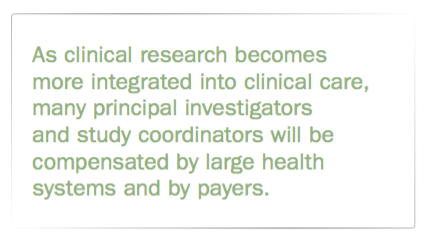
spaces within public facilities and individual’s homes.
Study conduct personnel will need to be trained to be effective and efficient as remote and flexible assets. As clinical research becomes more integrated into clinical care, many principal investigators and study coordinators will be compensated by large health systems and by payers.
Wearable and remote technology solutions will be critical to a more flexible clinical research operating model
Data collection is expected to be immediate, seamless and extremely convenient. Vital health statistics, including blood pressure and heart rate, will be monitored continuously increasingly with the assistance of artificial intelligence. The majority of patient data collected will be delivered directly from the patient to the electronic health record (EHR).
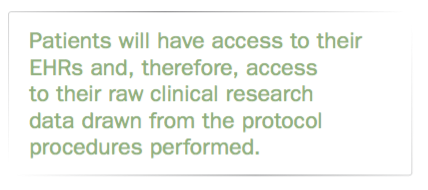
Increasingly, patients will use wearable and implantable devices as they participate in clinical trials while they go about their daily lives. Patients will receive frequent, real-time updates and reminders associated with their clinical trial participation responsibilities. And research professionals will receive real-time progress reports and summary data on clinical trial performance and quality. Patients will have access to their EHRs and, therefore, access to their raw clinical research data drawn from the protocol procedures performed. The personalized results of their clinical trials will be posted to the EHR and accessible to each patients primary and specialty health care providers.
Use of predictive analytics will become standard practice
Predictive analytics will become a preferred means to monitor and manage disease; to support clinical research recruitment, retention and pharmacovigilance; and to detect therapeutic benefit. Futurists anticipate that EHR systems will be standardized globally. Precision medicine, immuno-oncology, and the use of biomarkers will continue grow. Improved understanding of biology and a deeper knowledge of biological processes will promote the development of more targeted and cleaner medical interventions. Predictive analytics will enable modified treatments and allow the use of telemedicine, for example, providing treatments for ICU patients in the comfort of their own home. The data will be represented globally and there will be expanded connectivity everywhere in the world.
Identifying patient populations will become faster and easier and testing new drugs for effectiveness within certain populations will lead to more rapid determinations of whether a drug has provided benefit and caused an adverse or no effect. Increasingly drugs will be tested in smaller cohorts under adaptive protocol designs. Patients will receive investigational therapies as part of normal healthcare.
Data will drive oversight and compliance and medicine will become more standardized
Regulatory oversight will continue to require demonstrated safety and efficacy of products. However, futurists anticipate that the regulatory approval process will change dramatically and become much more efficient. Payment will be integrated into drug approvals and payers will pay on value with real-world evidence having more of an impact. Observational research and real-world data will be integrated into the approval process. The value of medicine will ultimately be determined on an individual basis.
The patient will own their data and they will take ownership of their role as partners in the clinical research process
Patients and the public-along with their network of healthcare support-will place increasing value on rich and dynamic health information to inform decision-making and improve health outcomes and public health.
Patients will increasingly view clinical research participation as an integrated healthcare option and research will be directed at the individual with inherent agreement to participate. A social responsibility to participate in clinical research at all times will become a societal norm and a source of pride.
Futurists anticipate that difficult ethical issues will need to be tackled around ownership of individual patient data (e.g., will individual patient data be proprietary to the individual, to the research sponsor, available to the broader health community?).
Study methodology
The Tufts Center for the Study of Drug Development (Tufts CSDD), an academic center within Tufts University Medical School, conducted in-depth interviews between March and June of 2016, examining the future of clinical research operations during the next 50 years.
Tufts CSDD researchers conducted in-depth interviews with more than a dozen industry experts and thought leaders on their vision about the future. Those interviewed had much industry experience in all aspects of clinical research and were contacted for their views on the future. The respondents hold various positions in industry, academia, and clinical settings, including attorney, CEO, Chief Medical Officer, Chief Scientist, Chief Technology Officer, Executive Director, Professor, and Director. Interviewees work in a myriad of organizations, including pharmaceutical and biotechnology companies, contract research organizations (CROs), investigative sites, law firms, non-profit organizations, standards organizations, technology companies, and universities. Their work experiences have driven their vastly unique perceptions regarding the future of clinical research.
Tufts CSDD gathered opinions and perceptions across a number of topics, including investigative site infrastructure, clinical trial scientific and management expertise, the role of technology and data, and clinical trial oversight and compliance. The research was sponsored by IBM Merge.
- Mary Jo Lamberti, PhD, is Senior Research Fellow, and Ken Getz, MBA, is Director of Sponsored Research Programs, both with Tufts CSDD
The authors would like to thank Ranjana Chakravarthy for her contribution to this article.
Historical Reflections on GCP
Of course, I wasn’t astonished at all to be informed by former colleagues in 2015 and 2016 that the ICH Guideline for Good Clinical Practice E6 was under revision. The final adoption by the Committee for Medicinal Products for Human Use (CHMP) in the European Union (EU) on December 15, 2016, 20 years after the approval of the original ICH GCP E6 guideline, was something that was going to happen one day.
For more than 20 years, in fact since September 1992 in Tokyo, when the ICH partners decided to work together on a Concept for Good Clinical Practices (at the same time as the World Heath Organization), authorities and the pharmaceutical industry were committed to propagate an international ethical and scientific quality standard for designing, conducting, recording and reporting trials that involve the participation of human subjects. No wonder that a journal was established to reinforce these efforts, to explain the guideline, to publish clinical trials related issues and solutions, to address monitoring, auditing and inspections. Applied Clinical Trials became a catalyst in the process of understanding and implementing correctly the principles of the standard.
Why were we, ICH E6 participants, so committed? A former EU official once told me that he thought that it was because the editor of the document had been herself the victim of bad clinical practices. Maybe it’s true. I know that in the case of many paragraphs of the standard, we provided examples of bad practices that we had encountered when monitoring and auditing in order to obtain clear guidance to prevent it in the future. We were also worried about financial and scientific fraud, which also became a topic for the readers of Applied Clinical Trials to understand.
In the EU, when the GCP inspection system was established, cooperation between authorities improved. Moreover, clinical trials conducted in third-world countries could be GCP-compliant as well. If clinical trials are conducted outside the EU, but submitted in an application for marketing authorization in the EU, they have to follow the principles, which are equivalent to the provisions of the Clinical Trials Directive.
In addition, if an application dossier submitted in accordance with the requirements of Regulation 536/2014 makes reference to data generated from a clinical trial conducted outside the EU, the clinical trial should be conducted in accordance with principles equivalent to those of Regulation 536/2014 as regards to the rights and safety of the subject and the reliability and robustness of the data generated in the clinical trial.
Moreover, such data should only be submitted in an application dossier if that clinical trial has been registered prior to its start in a public register that is a primary or partner registry of, or a data provider to, the WHO
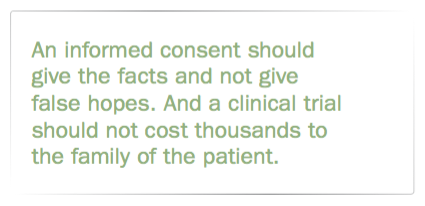
International Clinical Trials Registry Platform (ICTRP). Or if the results of that clinical study have been published in an independent peer-reviewed scientific publication. And such trials are subject to inspections!
You would think, or at least hope, that all these efforts after so many years created a full understanding and willingness by each investigator, by each partner in R&D, by each ethics committee and authority, wherever in the world, to assure that the rights, safety and well-being of trial subjects are protected, consistent with the principles that have their origin in the Declaration of Helsinki, and that the clinical trial data are credible.
And then, recently, I was horrified to read that there had been in my region an investigator at a university hospital who disregarded these principles; who had been requested two years ago by the university to leave in silence, who continues trials today in a private hospital in a neighboring country.
I felt we failed. We failed to persuade such an investigator that the regulations are not an administrative burden, a loss of time for medical doctors and terminally ill patients. An informed consent should give the facts and not give false hopes. And a clinical trial should not cost thousands to the family of the patient. I felt devastated. And just at that moment, I read the request to reflect on 25 years of GCP for Applied Clinical Trials.
I believe that, more than ever, we need the guideline for Good Clinical Practice E6 (R2), which came into effect in the EU on June 14. And I am convinced that Applied Clinical Trials and others need to propagate the understanding of the principles of GCP. I sincerely wish that both the authorities and the partners in GCP are successful in the implementation of GCP to the benefit of the trial subjects and R&D.

- Marijke Korteweg is currently a member of the review committee for Dutch Flemish Accreditation Organization. She previously was Integrated Quality Management (IQM) Advisor/Head Internal Audit at the European Medicines Agency, and was a member of Applied Clinical Trials Editorial Advisory Board for over 12 years.
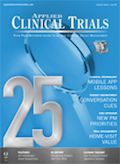
Improving Relationships and Diversifying the Site Selection Process
April 17th 2025In this episode of the Applied Clinical Trials Podcast, Liz Beatty, co-founder and chief strategy officer, Inato, discusses a number of topics around site engagement including community-based sites, the role of technology in improving site/sponsor relationships, how increased operational costs are impacting the industry, and more.
Behind the Buzz: Why Clinical Research Leaders Flock to SCOPE Summit
February 7th 2025In this episode, we meet with Micah Lieberman, Executive Conference Director for SCOPE Summit (Summit for Clinical Ops Executives) at Cambridge Innovation Institute. We will dive deep into the critical role of collaboration within the clinical research ecosystem. How do we bring together diverse stakeholders—sponsors, CROs, clinical trial tech innovators, suppliers, patients, sites, advocacy organizations, investors, and non-profits—to share best practices in trial design, program planning, innovation, and clinical operations? We’ll explore why it’s vital for thought leaders to step beyond their own organizations and learn from others, exchanging ideas that drive advancements in clinical research. Additionally, we’ll discuss the pivotal role of scientific conferences like SCOPE Summit in fostering these essential connections and collaborations, helping shape the future of clinical trials. Join us as we uncover how collective wisdom and cross-industry partnerships are transforming the landscape of clinical research.
FDA-Approved Gene Therapy Beqvez Shows Sustained Efficacy, Safety in Long-Term Hemophilia B Trial
April 17th 2025Beqvez (fidanacogene elaparvovec), an FDA-approved one-time gene therapy for hemophilia B, demonstrated sustained factor IX expression, low bleeding rates, and a favorable safety profile over long-term follow-up.